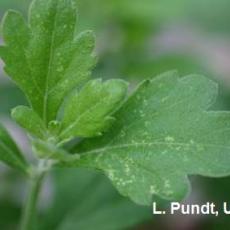The tarnished plant bug is a very general feeder, attacking many kinds of trees and herbaceous plants. It feeds on many flowers including dahlia, aster, calendula, chrysanthemum, cosmos, gladiolus, poppy, salvia, daisy, sunflower, verbena, zinnia, and others. It has piercing-sucking mouth parts as do all the true bugs. The long sucking mouthpart is inserted into the plant tissues and introduces toxic saliva into the plant as it feeds. The toxin kills cells near the feeding site causing the distortion of the growth surrounding their "sting marks", yellow or brown spots or wilting of new growth. In this photo, the flower does not fully develop. The heaviest injury often occurs during mid to late summer and is most evident during hot, dry weather, especially adjacent to recently cut hay fields. The first few generations develop on preferred hosts such as small grains, alfalfa, wild grasses, vetch, dock, and fleabane. As hay is cut or as other plants dry out, tarnished plant bugs migrate in large numbers to succulent hosts, which may be your cut flowers or garden mums.
Fact Sheet: Field Grown Cut Flowers: Tarnished Plant Bug

